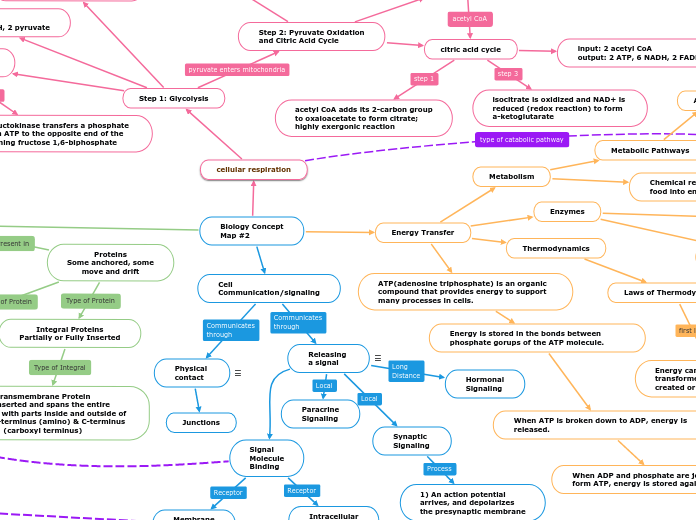Biology Concept
Map #2
Energy Transfer
Enzymes
Cycle
Regulation of enzyme function
Noncompetitive inhibitor
Competitive Inhibitor
Thermodynamics
Laws of Thermodynamics
Energy can be transferred and
transformed, but it cannot be
created or destroyed
Every energy transfer or transformation increases the entropy of the universe
Entropy - a measure of disorder
in the universe
Cell
Communication/signaling
Physical
contact
Junctions
Releasing
a signal
Paracrine
Signaling
Hormonal
Signaling
Synaptic
Signaling
1) An action potential
arrives, and depolarizes
the presynaptic membrane
2) Voltage-Gated
channels open and
Ca ions enter the cell
3) The high Ca
concentration cause
neurotransmitters to
be released into the
synaptic cleft
4) The neurotransmitter
binds to ion channels. This
may allow Na and K ions to
diffuse through
cellular respiration
Step 1: Glycolysis
Step 2: Pyruvate Oxidation
and Citric Acid Cycle
Step 3: Oxidative Phosphorylation
chemiosmosis
H+ goes back down the
concentration gradient through
a membrane transfer protein
energy associated with the gradient is
used to add Pi to ADP to form ATP
output: 26-28 molecules of ATP
electron transport chain
energy is released as electrons
move down the chain
energy pumps H+ against
the concentration gradient into
the intermembrane space
pyruvate is oxidized;
forms acetyl CoA
input: 2 pyruvate
output: 2 acetyl CoA, 2 NADH
citric acid cycle
input: 2 acetyl CoA
output: 2 ATP, 6 NADH, 2 FADH
isocitrate is oxidized and NAD+ is
reduced (redox reaction) to form
a-ketoglutarate
acetyl CoA adds its 2-carbon group
to oxaloacetate to form citrate;
highly exergonic reaction
occurs in the cytoplasm,
outside of the mitochondria
input: glucose, 2 ATP
output: 4 ATP, 2 NADH, 2 pyruvate
breaks down glucose into
2 molecules of pyruvate
phosphofructokinase transfers a phosphate group from ATP to the opposite end of the sugar, forming fructose 1,6-biphosphate
hexokinase transfers phosphate
group from ATP to glucose to form glucose-6 phosphate
Cell Membranes
Phospholipid Bilayer
Each phospholipid has a hydrophobic fatty acid tail and a hydrophilic head (due to the presence of a phosphate group). They are amphipathic molecules.
Unsaturated Fatty Acid Tail
Lipids are not tightly packed
and can move in the membrane
Saturated Fatty Acid Tail
Lipids are tightly packed
and cannot move
Temperature
Above a temperature, the lipid is fluid.
Below, the lipid is in a gel phase and rigid.
Cholesterol
Presence between phospholipids around 37°C, movement is reduced. At low temperatures, packing is prevented.
Proteins
Some anchored, some
move and drift
Peripheral Proteins
Anchored to the membrane
Integral Proteins
Partially or Fully Inserted
Transmembrane Protein
Fully inserted and spans the entire membrane with parts inside and outside of the cell. N-terminus (amino) & C-terminus (carboxyl terminus)
G protein couple receptor
G Protein
Enzyme
Signaling Molecule
Plasma Membranes are
selectively permeable
Hydrophobic molecules can easily cross
the membrane while polar molecules do not
Polarity and size determines whether it can cross rapidly, slowly, or not even at all.
Types of Transport
Passive Transport
Diffusion of a substance across
a membrane with no energy investment
Signal
Molecule
Binding
Membrane
Receptor
Step 1: Reception
Step 2: Transduction
Step 3: Response
Protein
Kinase 1
Activated
Kinase 1
Activates
Kinase 2
Kinase 2
Phosphorylates
a protein
Protein
Phosphatase
removes
Phosphate group
from Kinases
Intracellular
Receptor
Step 1: Signal
molecule passes
through membrane
Step 2: Signal
molecule binds
to receptor protein
Step 3: Signal-Receptor
complex enters the
nucleus
Step 4: Protein prompts
transcription of gene
into mRNA
Step 5: mRNA is
translate into a
specific protein
Signal molecule is
nonpolar/hydrophobic
Diffusion
The tendency for molecules to spread out,
moving from areas of high concentration to low concentration.
Osmosis
Diffusion of water across a membrane from a lower solute concentration to a higher solute concentration until it's equal on both sides.
Tonicity
Ability of a solution to cause a cell to
lose or gain water
Isotonic
Solute concentration is the same
inside and outside of the cell.
Hypertonic
Solute concentration is greater
on the outside of the cell.
Hypotonic
Solute concentration is greater
on the inside of the cell.
*Animal cells are best in an
isotonic environment
*Plant cells are best in a
hypotonic environment (turgid)
Facilitated Diffusion
Passive transport but
aided by proteins
Aquaporin transports water across the
membrane. The amino acids with polar R goups make up the interior of the protein while the exterior part of the protein is made up of amino acids with non polar R groups.
Channel Proteins
Provide channels that allow a
specific molecule to cross
Ligand-gated
Open and close when
a neurotransmitter binds
to the channel
Voltage-gated
Open and close in response
to changes in membrane potential
Stretch-gated
When the membrane
is deformed
Carrier Protein
Undergo a change in shape that
moves the solute across. Typically triggered by the binding and release of the molecule.
Ungated
Always Open
Active Transport
Needs energy to transport molecules
from low to high concentration
Bulk Transport
Large molecules like polysaccharides
and proteins cross the membrane
through vesicles
Electrogenic Pump
Proteins or pumps that create
a voltage difference across membranes. The energy harvested can be used for cellular work
Na+/K+ Pumps
&
Proton Pumps
Cotransport
When the active transport of a solute
drives the transport of other substances.
Sucrose being transported against
the concentration gradients uses energy created from the movement of H+ ions down the concentration gradient
Exocytosis
Endocytosis
Phagocytosis
The cell engulfs large
food particles/other cells by
extending part of the membrane
Pinocytosis
The cell takes in extracellular
fluid from the outside through vesicles
Receptor Mediated Endocytosis
Specialized pinocytosis that allows the
cell to acquire bulk amounts of specific substances
ATP(adenosine triphosphate) is an organic compound that provides energy to support many processes in cells.
Energy is stored in the bonds between phosphate gorups of the ATP molecule.
When ATP is broken down to ADP, energy is released.
When ADP and phosphate are joined to form ATP, energy is stored again.
